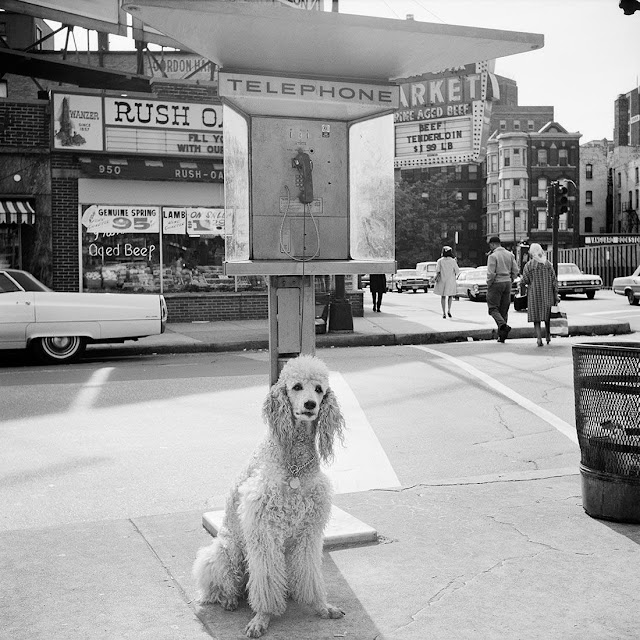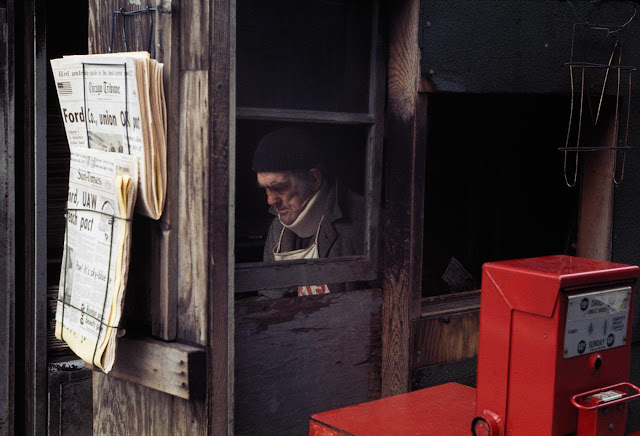When John Maloof, a real estate agent, amateur historian, and garage-sale obsessive, acquired a box of photographic materials and personal detritus at an auction in suburban Chicago in 2007, he quickly realized that he had stumbled upon an unknown master of street photography. But despite his vigorous snooping, he could find no record of Vivian Maier, the name scribbled on the scraps of paper that he found among the negatives, prints, and undeveloped rolls of film. He tracked down the rest of the boxes emptied from an abandoned storage garage, amassing a collection of hundreds of thousands of frames shot in New York, Chicago, France, South America, and Asia between the nineteen-fifties and the nineteen-seventies.
Two years after he bought the first box, he Googled the name again and, to his surprise, found an obituary announcing that Vivian Maier had died only a few days before. The short text had just enough information for Maloof to deduce that Maier had worked as a nanny in suburban Chicago.
Vivian Dorothea Maier was born in New York, New York, on February 1, 1926. She spent much of her childhood in France, starting at the age of four in 1930. She briefly lived in close quarters with a noted female photographer, Jeanne Bertrand, who may have taught the young Maier how to take pictures when she was a girl. After 1949 she moved back to New York City, learning English by going to movie theaters.
In 1951 she came to Chicago to work as a nanny for a North Shore family. She worked for several north shore families over the next 40 years. Maier was a very private person who pursued her photography interest in her spare time and on days off. She never showed her photographs to anyone.
 |
| Vivian Maier Self Portrait |
Most of Maier's photographs were taken with twin-lens Rolleiflex cameras. The Rolleiflex camera's viewfinder is top-down, so it is held inconspicuously at hip height, looking down. Maier was able to capture fleeting moments and turned them into something extraordinary.
VIVIAN MAIER'S CAMERA HISTORY
Vivian Maier’s first camera was a modest Kodak Brownie box camera with one shutter speed, no aperture, and focus control. In 1952 she purchased her first Rolleiflex camera. Over the course of her career, she used Rolleiflex 3.5T, Rolleiflex 3.5F, Rolleiflex 2.8C, Rolleiflex Automat, and others. She later also used a Leica IIIc, an Ihagee Exakta, a Zeiss Contarex, and various other SLR cameras.
Maier used mostly Kodak Tri-X and Ektachrome film.
 |
| Rolleiflex Camera |
It seems that, for Maier, the nanny’s life allowed her to be with people, but not of them. She actively cultivated her own unknowability, perhaps as a way to maintain this separateness. She never spoke of a desire to make a living as a photographer. In Chicago, where she lived for decades, she refused to give film processors and pawn shopkeepers her real name instead of handing out fake names everywhere. She demanded separate locks for her rooms in her employers’ houses and forbade anyone from ever entering her space. She didn’t mention family or old friends. She lied about where she was born, claiming France as her homeland (she was born in New York City), and spoke with a contrived Continental accent that no one could place. She dressed in an outdated style, like a Soviet factory worker from the 1950s. An acquaintance recalls asking Vivian what she did for a living. Her response: “I’m a sort of spy.”
Her archives of pictures, films, and voice recordings reveal a fascination with rape and murder, urban blight and the ravages of poverty, the brutality of the city stockyards, and political unrest.
There’s no disputing that Maier was peculiar and prickly and that her interests spanned the benign and the morbid. But she was neither a Mary Poppins nor a surrogate Mommie Dearest. The people who knew her described impenetrability that, even in retrospect, threatens the fantasy that people who choose to care for children are all hugs and rainbows.
Maier had neither money nor connections, but she had control over how she lived, what she looked at, and what she photographed.
Her photographs (see Chicago and Illinois photo album below) of the urban and suburban streets track the fluctuations of the economy, the growth of the city, the cycles of the seasons, the emotions in the faces of the children she cared for, the way her own body advanced through the years. She chose her job not because she especially loved children, but because of the life it enabled her to have, what it allowed her to see. She valued her freedom above all. Her art and profession have more in common than they may initially seem. She was a perpetual outsider, and she liked it that way. She moved among people but did not belong to any of them. She was close but not entangled. She could always walk away.
Maier spent the late fifties and sixties traveling and photographing the world alone. It seemed that, on those trips, Maier was the freest she had ever been and ever would be. That’s how she wanted to see herself. And she did.
Well, I suppose nothing is meant to last forever. We have to make room for other people. It’s a wheel. You get on, you have to go to the end. And then somebody has the same opportunity to go to the end and so on. —Vivian Dorothea Maier
She lived her final years in the Rogers Park community of Chicago and was unknown and impoverished. It was not until after her death in 2009 that her life’s work was accidentally discovered. Since then, her photographs have been exhibited throughout the world.
Her pictures help us to understand that Maier wasn't invisible except to us. She was looking at herself all along.
Vivian Dorothea Maier died on April 21, 2009, in Oak Park, Illinois. She was cremated and had her ashes scattered, Specifically by the Gensburg sons, likely in the Catherine Chevalier Woods in the Forest Preserves of Cook County, near Chicago's O'Hare Airport.
Finding Vivian Maier | 2015 Oscar Nominee | Official Trailer
Compiled by Dr. Neil Gale, Ph.D.
CHICAGO & ILLINOIS
 |
| Maxwell Street, Chicago, Illinois, 1962 |
 |
| What are these kids looking at? |
 |
| Hull House, Chicago, IL., January 31, 1963. |
 |
| Kiddieland, Sandwich, IL., September 1966. |
Vivian Maier Self Portraits
VIVIAN MAIER'S CAMERA HISTORY
Vivian Maier’s first camera was a modest Kodak Brownie box camera with one shutter speed, no aperture, and focus control. In 1952 she purchased her first Rolleiflex camera. Over the course of her career, she used Rolleiflex 3.5T, Rolleiflex 3.5F, Rolleiflex 2.8C, Rolleiflex Automat, and others. She later also used a Leica IIIc, an Ihagee Exakta, a Zeiss Contarex, and various other SLR cameras. Maier used mostly Kodak Tri-X and Ektachrome film.















































